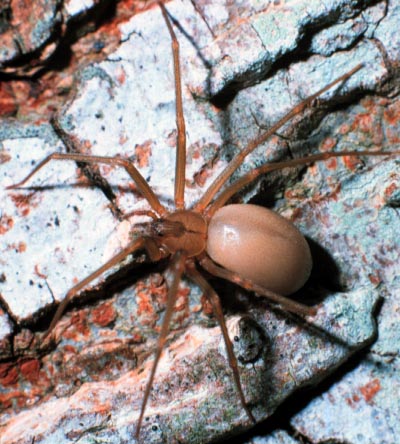
A recluse spider, Loxosceles sp. (Araneae: Sicarlidae), female.
Photo by Jackman.
Common Name: Recluse spider
Scientific Name: Loxosceles sp.
Order: Araneae
Description: The shape of the cephalothorax (head-thorax) region and darkened violin markings on the carapace (top of the cephalothorax) are useful identification marks for most of our recluse spiders. Recluse spiders have six eyes in three pairs or diads and a carapace that is quite flat when viewed from the side and highest near the head. The fangs or chelicerae are fused at the base. The color is generally yellowish brown but it can vary. The most distinctive mark is the darker violin shape on top of the carapace. The base of the violin mark is at the front of the carapace and the “neck” of the violin extends backward toward the abdomen. Body length of the female is 3/8 inch; length of the male 5/16 inch.
Recluse spiders are also known as violin spiders, or brown spiders. There are thirteen species of Loxosceles in North America. Four other species in the genus recorded from Texas are: the Big Bend recluse, L. blanda (Gertsch and Ennik), from West Texas; the Texas recluse, L. devia (Gertsch and Mulaik), from Central and South Texas; L. apachea (Gertsch and Ennik); and L. rufescens (Dufour) from scattered locations across the state. The Texas recluse may be the most common species in Texas and is often mistaken for L. reclusa. Other species in the genus should also be considered poisonous. These other species are very similar but the “violin” markings vary somewhat. Species determinations should be completed using genitalia.
Life Cycle: Mating season is from April to July. Females produce up to 5 egg sacs containing about 50 eggs in each. Development to adult may take nearly one year. Laboratory records indicate that they may live for several years as adults. The spiders form a loose irregular sheet web which is used to capture prey and as a retreat. They also form loosely constructed egg sacs that are attached to a surface.
Habitat, Food Source(s), Damage: The brown recluse occurs from Ohio south to Georgia and west to Nebraska and Texas (although there are no records yet from the Lower Rio Grande Valley). They usually occur found under logs, stones, or other sheltered areas, preferring undisturbed habitats. They can be found indoors where they hide in dark corners, in trunks, under stored clothing, and around almost any undisturbed structure. They are commonly seen moving around at night, undoubtedly hunting.
Pest Status: Most frequently associated with bites of medical significance; venom is potentially harmful to humans. Recluse bites usually form a red circular area on the skin which sloughs off the skin leaving an open wound which is difficult to heal and may require several months before it is completely healed. Reactions vary in severity, depending on the sensitivity of the individual. Seek medical attention if such a bite occurs. This spider is quite non-aggressive and bites occur most frequently when it is injured or killed. This may happen when trapped in clothing or bedding. Bites often occur on the buttocks or legs. They typically produce local pain and itching which may take days or over a week to occur. Systemic (generalized internal) reactions usually are evident within 72 hours. The bite site may develop a discolored pustulate area that progresses to a necrotic area with an open wound the size of a quarter or larger. Systemic reactions may include rashes, fever, generalized itching, vomiting, diarrhea, shock or death. Surgical removal of the bite site has also been tried but is not generally advised. Nitroglycerin patches are also used.
For additional information, contact your local Texas A&M AgriLife Extension Service agent or search for other state Extension offices.
Literature: Kaston 1978; Levi et al. 1990; Gertsch & Ennik 1983; Demmler et al. 1989.